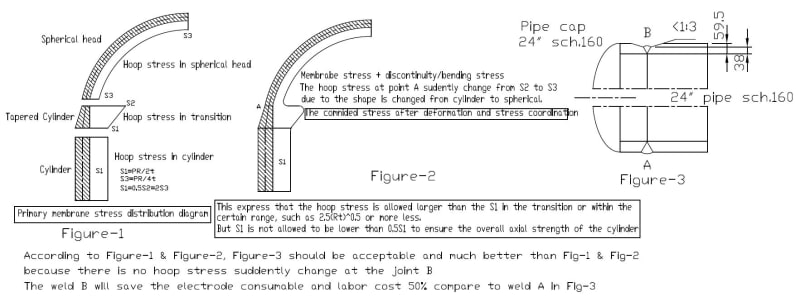mechengineer
Mechanical
Point-1, Please see Fig-1 & Fig-2 as the attached, refer to Figure UW-13.1 as well, showing that the hoop stress in cylinder transition is larger than S1=PR/2t in the transition. Do you agree?
But S1 shall not allowed to be lower than 0.5S1 to ensure the overall axial strength of the cylinder at the transition small end. In another word, the longitudinal stress at the small end of the transition shall be equal or smaller than the hoop stress at the larger end of the transition.
Point 2, Fig-3, except the view of point 1, it is similar to small opening concept as well, the cylinder would not be able to crack at point B (very narrow width, Fig-3) along the cylinder generatrix. I know that the weld B in Fig-3 is not allowed by code, that being the case, how to explain Fig-1?

[URL unfurl="true"]https://res.cloudinary.com/engineering-com/image/upload/v1660402753/tips/Shell_to_Head___LinkedIn_ubymoe.pdf[/url]
But S1 shall not allowed to be lower than 0.5S1 to ensure the overall axial strength of the cylinder at the transition small end. In another word, the longitudinal stress at the small end of the transition shall be equal or smaller than the hoop stress at the larger end of the transition.
Point 2, Fig-3, except the view of point 1, it is similar to small opening concept as well, the cylinder would not be able to crack at point B (very narrow width, Fig-3) along the cylinder generatrix. I know that the weld B in Fig-3 is not allowed by code, that being the case, how to explain Fig-1?

[URL unfurl="true"]https://res.cloudinary.com/engineering-com/image/upload/v1660402753/tips/Shell_to_Head___LinkedIn_ubymoe.pdf[/url]
